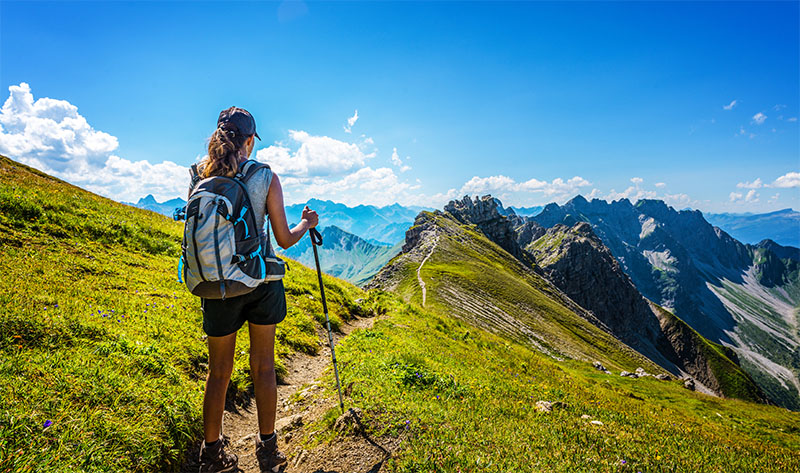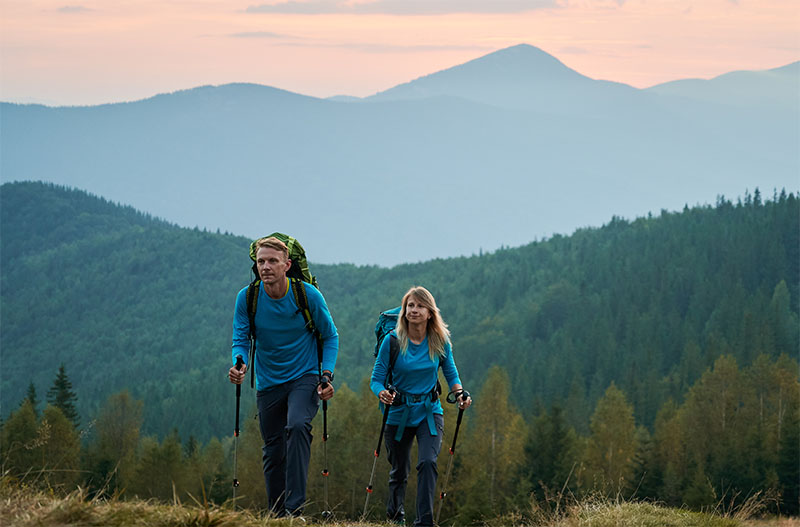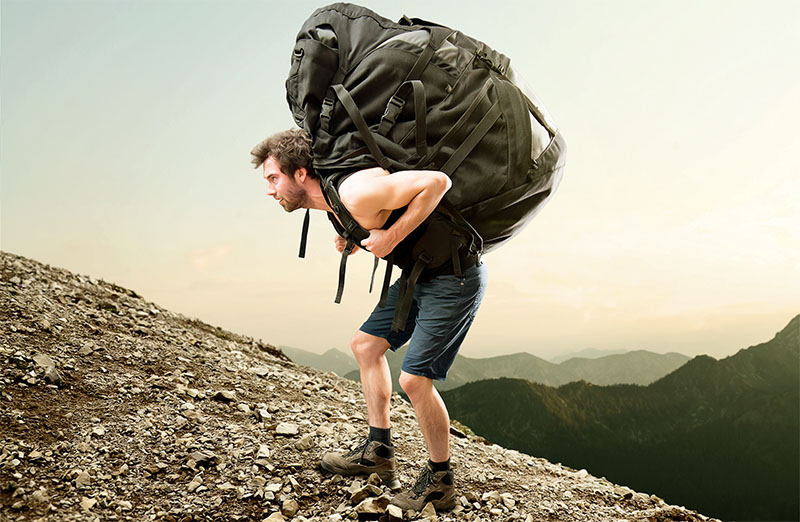Contents
Did you know that over 44 million people go hiking each year? With its amazing benefits and relative affordability, it’s no wonder it is so popular!
One of the big draws for hiking is that it offers so much variety. Every hike is unique. Some hikes are straight up a mountainside while some are flat and follow the edge of a lake. Some hikes are 100 feet to an amazing lookout while others are a fifty-mile loop. No matter where you are at or what you are looking for, there is bound to be a hike for you!
When you are searching for the perfect hike, it’s important to know and be able to estimate how long it will take you. Below, we’ll discuss why this is so important as well as how to calculate and improve your hiking speed and more!
What Is The Average Hiking Speed?

According to the New York Times, the average hiker walks about one mile for every thirty minutes, or two miles per hour. However, if you are hiking briskly, you can definitely do better than the average. Speed hikers can get in 4 or 5 miles for every hour and trail runners can do around 8.
While this may be the average hiking speed, every hiker will have his or her own average.
Calculating Your Average Hiking Speed
As we’ll discuss below, there are many factors when hiking that can affect your average hiking speed. But, there are two ways we can calculate your average hiking speed. First, you can calculate it before you go hiking to see how long it will take you. And, the second way you can calculate it is after you go hiking to see what your average speed was after the fact.
Let’s say you are trying to decide what trail you want to take for your hike and you are thinking about doing a 6 mile out and back. If you only have a certain amount of time and you want to know, on average, how long it will take you, you can simply take the total number of miles and divide that number by 2. So, in this case, you will take 6 and divide it by 2 and get 3.
This means that it would take you about 3 hours, 1.5 hours to get to your point of interest and 1.5 hours to get back to the car. Doing this is always important before you go hiking to understand the supplies you will need and how much time you should allot for your journey.
Now, if you want to calculate your average speed on a trail that you have already hiked, you will take the number of miles and divide that by the number of hours it took you. For example, if you went on an 8 mile hike with some friends and it took you guys 5 hours, you would take 8 and divide it by 5. This gives you 1.6 miles per hour, which would be your average pace.
Why Knowing Your Hiking Speed Is Important

I touched on this just a little above, but it’s important to reiterate how important it is to know your hiking speed. Let’s look at the most important reasons…
Determine Start Time
Now, if you’re going to go for a 3 mile hike, it really doesn’t matter what time you leave (unless it’s the heat of the day or at night). However, if you’re wanting to tackle a 10 or 12 mile hike in one day, it’s good to know your average hiking speed so that you can estimate when you will be back to your car.
The longer it will take you, the earlier you will need to start, but it’s also important to consider other variables when determining your start time including weather conditions and temperature. It’s also important to note that you should always allot more time than your average just in case something comes up! You’d always rather finish earlier than expected than come in late and in the dark!
Know your Limits
If you know your hiking speed, you can discern an appropriate length of trail you can accomplish if you’re wanting to go for a day hike. Knowing this important knowledge will enable you to make smart decisions within your limits and what you can accomplish.
Determine Supplies Needed
Knowing your average hiking speed will help you decipher the amount of supplies you will need for your hike! Of course, you should always be prepared with the basics, but it can help you determine how many snacks you should bring, if you need that extra bottle of water, or if you’ll need a jacket!
Safety
One of the most important reasons for knowing your average hiking speed is so that you can share this information with family or friends. There are many mountains and trails that have very limited cell service. If you know you are going into a situation where you will not have the best access to others, it is a great safety measure to share with a family member or close friend where you are going and the estimated time it should take you. That way, if you are a lot later than expected, they will know your location and what to do if there is an emergency.
What Causes Hiking Speeds To Vary on the Trail

Even though knowing your average hiking speed is helpful, it’s always important to understand that this is not an exact science. It’s crucial that you take this estimation with a grain of salt and know that there are a multitude of circumstances that can alter your average hiking speed. Here are the most common ones…
Elevation Increases
Increases in elevation can really slow you down! Some even say that you should actually account for the amount of elevation when estimating your hiking speed by adding an extra 45 minutes of hiking time per 1000 feet of elevation gained. If you think about it, it makes sense. Going up a flight of stairs can get me winded on any day. Imagine hiking up a mountain! The more tired your body gets, the longer it will take to reach your destination.
Uneven Terrain
This may not be as obvious as elevation gain being something that will affect your hiking speed, but it truly is. When you are hiking on flat, well-groomed ground, you can walk briskly with ease. But, the more uneven things are, the more you have to focus on your walking, making sure that you do not trip up on a root or roll your ankle by stepping on a rock the wrong way. Because it requires more attention and brain power, you will need to slow down and be more calculated with your steps on uneven terrain.
Fitness Level
Fitness level is another big one that will affect your speed. The great thing about this one is that you can improve it on your own! It makes sense, really. The better shape you are in, the easier it will be.
Pack Weight
Backpacker.com estimates that every 1% of your bodyweight that your backpack weighs will slow you down 6 seconds each mile? While this may not sound like much, it can really add up, especially if you are hiking with food and camping gear for a multi-day trip.
Let’s say that you weigh 200 pounds. So, every 2 pounds your backpack weighs, you add 6 seconds to your mile. Say you have a 40 pound backpack. That means you will be 2 minutes slower per mile of your trek.
Breaks Taken
The number of breaks taken may also coincide with fitness level, but not necessarily. Sometimes people will take more breaks for lunch or snacks, but more often than not they will encounter beautiful views, wildlife, and other things in nature that will entice them to stop and look. While this is one of the most important things about hiking, it’s also important to keep in mind your hiking speed if you are on a tight schedule.
How To Measure Your Hiking Speed

While I shared with you above how to calculate your average hiking speed, there are actually different ways to measure your hiking speed. Let’s look at the most common ways..
GPS
You can easily use a GPS to measure your hiking speed. Most people will have a watch, like an Apple watch or a Garmin, that is GPS enabled and will help you keep track of your speed, elevation gain, and so much more. Another way people will use a GPS on the trails is with a phone that has GPS capabilities and has a hiking app. Either option is a great way to keep up with your hiking speed.
Fitness Trackers
Most fitness trackers are in either watch form or app form on a phone, but the major difference here is that they are not GPS enabled. This means that they will not be as specific and have as much detailed feedback, but they can keep up with your mileage hiked, your time, and your pace just as well.
Manual Method
Most folks don’t need a fancy way to keep up with their speed when they’re on the trails. They may not want to have the distraction of technology or they may just not have the technology, and that is totally fine! You can easily keep up with your speed by looking at the time you have been hiking and divide that by the distance. For example, you’ve been hiking for 35 minutes and you just passed a mile marker letting you know that you’ve gone 1.25 miles. Here, you are on track for hiking 28 minute miles.
You can do this as you go or when you’ve completed your hike. Either way, it’s easy to do!
Ways To Increase Your Hiking Speed

If you’ve been hiking for some time and you’re not happy with your hiking speed, you can easily work to increase it! Here are some ways…
Physical Conditioning
As I shared above, your physical fitness can affect your average hiking speed. If you want to see improvements in this average, my first suggestion is to work on your physical conditioning. Get in some workouts throughout the week that will get your heart pumping and your endurance up, and you will definitely see improvements!
Decrease Pack Weight
Maybe your backpack is slowing you down? If so, that’s an easy fix! You don’t have to sacrifice the necessities for a hike, you just need to get creative! If your actual backpack is too heavy or too big, can you invest in a smaller one? Maybe your first aid kit could be consolidated or put in a lighter container? Possibly get a hydration bladder instead of a bulky water bottle? Think creatively, and I’m sure you can find some ways to lighten your load!
Consume Calories
This may not be something you’ve thought about, but making sure that you’re properly fueled will actually increase your hiking speed! If you are hungry and inadequately nourished, you will not have the energy to hike up that hill. You’re going to need more breaks.
It’s actually recommended that you consume around 200 calories for every hour of hiking. So, plan to bring plenty of snacks if you want to make a good time!
Take Shorter Breaks
The last way that you can increase your average hiking speed is to take shorter breaks. This is a culmination of all the other tips as well because if you are in better shape, properly nourished and hydrated with a lightweight pack then you will probably require fewer breaks throughout.
Conclusion
According to the New York Times, the average person can hike 2 miles per hour. Knowing your average hiking speed is important for multiple reasons, such as determining your start time, knowing your limits, determining supplies (think food, water & clothing) needed, and most importantly for safety.
The are a few ways in which you can measure you hiking speed. The easiest and most accurate way to measure your hiking speed is with GPS. Another way to measure hiking speed is via fitness trackers and the last way is the good ole manual method. To manually calculate your hiking speed, divide the time you have been hiking by the distance hiked.
If you are not happy with your hiking speed and want to increase it, there are a few things you can work on. First, increasing your physical conditioning will definitely help. Second, decreasing your pack weight is always a good thing and will enable you to move faster. Third, make sure you are replacing calories that you are burning. You are supposed to consume 200 calories for every hour of hiking. Last, taking shorter breaks will help to increase your average hiking speed.
